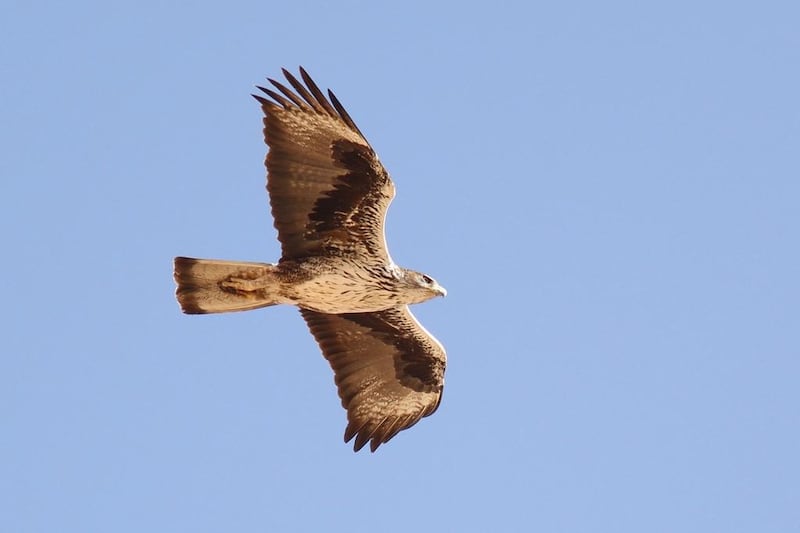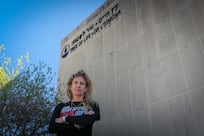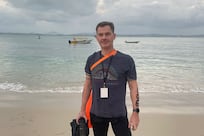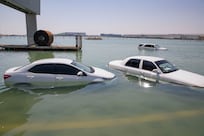At first light, I scale the arid hillside, my feet skidding on crumbling rock. Breathless and exhausted, I finally stop on a flat roof. I gaze skywards, scrutinising the mountain ridge like a famished falcon, the valleys and plains around me hushed and deserted. There, I wait for savage inhabitants of some of the world's most revered summits – the birds of prey of the High Atlas.
These North African peaks are home to formidable aerial predators – falcons, eagles, hawks and vultures. Abrupt, crimson cliffs provide perfect lodgings for birds that nest only in the most unreachable clefts of the sheerest precipices. Add vast kilometres of plains between the Atlas range and fruitful hunting ground, and they’re in perfect territory.
Our trek begins at Oukaimeden village and the mountain upon which it stands, 2,400 metres tall. It’s one of the lesser peaks that accompany North Africa’s highest, the kingly 4,000-metre Mount Toubkal. Snow crowns the surrounding summits from November until at least March. Come the winter months, Moroccans flock here to ski, but we were interested in other species; ones that steer away from crowds and are a good sight more graceful. The Atlas raptors.
On our wish list is Earth’s fastest creature, the peregrine falcon, which can fly up to 380 kilometres per hour, as well as other varieties – the Barbary, red-footed and sooty falcons. We’re thrilled at the prospect of sighting a golden eagle or perhaps a pair of Bonelli’s eagles.
“You may also see the snake eagle, which feeds on reptiles, the booted eagle, sparrowhawk, and look out for the Egyptian vulture, which migrates from Africa and nests in May,” says Brahim Bekkas, an ornithological guide and president of the Moroccan ornithological group Gomac (Groupe d’Ornithologie du Maroc).
Having read many accounts of these creatures, we naively expect them to be swooping over our heads and plummeting from above at lightning speed, as we pull on our walking boots. Will they swoop in on our picnic? Should we strap our children to our chests?
But to spot birds like these, you need eyes as sharp as a hawk – and binoculars. Buy or borrow a quality pair (instead of the cheap plastic variety I’ve procured), and unless you’re a seasoned ornithologist, enlist an experienced guide well-versed in all things avian. Birds of prey don’t experience the same vision-based drawbacks. Their eyes are inbuilt binoculars, working as magnifying glasses and telescopes; their necks turn 270 degrees. Superlative vision enables raptors to intensify warm colours, meaning animals’ camouflage is less effective. Their eyes are proportionally enormous – as big as saucers on a human head.
Our guide, Youssef El Ouali, has accompanied adventurous visitors over the multifarious terrains of Morocco for 15 years, and accumulated a thousand exciting animal sightings to recount. He’s seen sand cats, jackals and even the bald ibis. He hopes to discover one day that the Barbary panther is not extinct, as feared.
The High Atlas chain parades east from the Atlantic coast towards the Algerian border. It’s a splendid concoction of terrifyingly precipitous red-earth cliffs leading to pockets of bright-green valley. Boundless plains – favourites for birds of prey at mealtimes – flank the mountain range. We head for the mountain hamlet of Gliz a few hours away, where we spend a night and do some birdwatching at dusk.
On initial inspection, the scorched slopes are barren of animal life. Even in early spring, after rain and snow, it’s bone-dry. Lizards shoot in and out of rocky cracks. Juniper bushes – some several centuries old – scrabble up the craggy hillside. Their berries attract birds from Nordic climes in winter and also appeal to the Barbary squirrel – a little striped thing that provides the ideal snack for predatory birds. One flashes across our path as we begin the descent, in blistering sun, with alpine-crisp air.
El Ouali suddenly pinches my shoulder, and points to a juniper tree. “Look there!”
I snatch my binoculars to my eyes.
“You see?” he asks.
“What?” I reply.
The bird in question is a patient specimen. It waits between the branches, and I finally spot it – after a considerable amount of time.
“I can see it,” I finally exclaim. With a blue head and chest, and orange belly, it’s very pretty. “A blue rock thrush,” El Ouali says. It promptly flies away.
“Keep your eyes peeled for the bone crusher,” El Ouali advises, instilling slight unease. We tighten our grips on our children. The lammergeier or bearded vulture is one of the most exciting feathered sights out there, and tops many an ornithologist’s bucket list. With its three-metre wingspan, this vast scavenger is nature’s personal janitor. Retrieving leftover bones from other animals’ feasts, it soars 80 metres high before dropping the bones, shattering them against rocks. This releases the marrow, the bone crusher’s favourite delicacy.
Sadly, the bird has become so scarce in recent years that it was thought extinct in Morocco, although happily a handful of pairs have since been sighted. “They have become very, very rare. Partly because of changes in conditions, but poisoning is one of the main reasons it’s under threat,” explains Bekkas. “Many shepherds believe that such birds steal lambs from flocks. This vulture would never steal live prey, but not everybody knows that, so they lace dead animal meat with poison, and vultures come and eat from the carcasses.”
Aside from the ever-increasing threats these ferocious yet vulnerable birds face, pairs defend enormous territories of between 50 to100 square kilometres, and are thus sparsely spread at the best of times.
Three hours and some whining leg-muscles later, we see Barbary partridges, alpine choughs, redstarts, mountain thrushes, mountain sparrows and a host of wood pigeons. But our sights are set on raptors.
I decide on a change of gear, scrambling through scraggy bushes and climbing onto jutting ledges of rock, dangling my feet over a heart-seizing drop. I sit as still as a stone for an hour. My binoculars weld red marks on my face, with my shoulders frozen, as obsession sets in.
We follow a brook to a waterfall, slipping on stepping stones. I see a jay with blue wings dart above the cascading flow, alongside chirping wheatears and an emerald African chaffinch. I’m getting desperate, though. Not one bird of prey.
A baby had been born in the mountain village just before we arrive at dusk. Women and girls are singing, thumping tambours and heels. Little has changed in these mountain hamlets in the past century, save the arrival of electricity, which is used frugally. Donkeys scuff up and down rough hill faces while children skit through passages, chickens screech and the scent of sheep and goat is overriding.
An infusion of green tea and sage is brought to us on the terrace, served with bread, olives and honey.
And then it happened. “Look. There,” El Ouali starts. I shoot my binoculars upwards. A falcon, a thing of immense grace, sweeps from the ridge high above us down through the valley, before soaring up again and over the mountain. The whole thing is only about four seconds of flight, but it’s my first ornithological surge of adrenaline. I lay awake well into the night in the darkness, listening for the eagle owl.
I have seen birds of prey before in Morocco, mournfully caged in a Marrakech souq. “Sadly, we find eagles, vultures and falcons illegally sold in souqs,” says Benoit Maire, an ornithological author and biology teacher. “They should never be purchased, and trading in or poisoning of protected species should be reported to the high commission.”
At dawn, I’m the proverbial early bird to catch the worm. I clamber onto the flat roof of a baked-earth village house – a superb vantage point over the valley and out towards the plains. It’s cold, but the sky graduates from blue to indigo to fiery orange. The village sleeps below. The only sounds are birdsong and the mountain brook. I sit with my head back, eyes raised. My patience finally pays off. Above the mountain crest, I see a pair of birds circling, gliding in splendid synchronicity. “A pair of golden eagles,” El Ouali whispers. “Nothing else would fly so high. They’re out searching for food.”
The dawn hunt of one of the planet’s most ancient creatures is an unrivalled spectacle. One dives suddenly, vanishes in a second, then resurfaces, sailing through the crisp air. They disappear over the apex of the frosted mountain and are gone.
Golden eagles, though not common, aren’t endangered in Morocco. “But some birds have disappeared,” Bekkas says. “The tawny eagle has totally gone, along with the beautiful vulture, and the dark chanting goshawk – we believe that it’s completely vanished from Morocco.
“These hunters are dying out because of disturbance to their natural habitat, construction on their territory, and disappearance of their prey because of deforestation, desertification and drought. This is almost exclusively human activity.”
Ornithologically inclined tourists can participate in protection by raising awareness and observing the birds in an ethical manner – avoid any disturbance, especially during breeding seasons, which is spring for most of the birds.
There’s a big job to be done, but Bekkas is hopeful. “We’re trying to inform locals about birds, explaining that they’re not enemies but friends. They are mountain inhabitants – just like the people – who have always existed,” he says. “As with all species, they deserve respect.”
weekend@thenational.ae
Follow us @TravelNational
Follow us on Facebook for discussions, entertainment, reviews, wellness and news.





